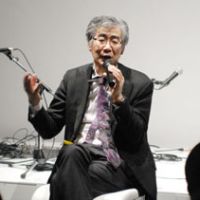Trying to understand contemporary art is difficult in the best of times. It is sometimes abstract, obscure or just plain odd. The question of how to enjoy an exhibit is made all the harder to answer if you're in Tokyo and your artistic attachments aren't matched by your Japanese language skills. Japan resident of 10 years, Patsy Brown, reckons she has the answer.
"I've been a member of the Mori Art Museum since they opened (six years ago)," the 32-year old Texan said during a special event for museum members held last month. "The members' events are all bilingual, and they really help you understand the art," she explained.
The event, called the "Mori Art Museum Contemporary (MAMC) Night," was held on a Tuesday evening after the museum had closed to the general public and featured a tour of the current exhibition — on contemporary Indian art — and a half-hour concert of sitar music. Members also had a chance to mingle and talk.
"It's great so far," Brown said after the tour segment of the evening. "The best part was when Fumio Nanjo (the museum director) told us some of the stories behind the show," she said.
Other members of the group appeared to agree. Nanjo's commentary on various exhibits — such as a giant sculpture of an elephant lying on its side — was greeted with a chorus of laughs, gasps and, from the Japanese participants, a number of exclaims of "naruhodo," indicating their curiosity had been satisfied. The non-Japanese guests were given headphones through which they heard a refreshingly adept simultaneous translation.
"At first, it had looked like we wouldn't be able to borrow that elephant," Nanjo said. "It is by the Indian artist Bharti Kher and belongs to the Queensland Art Gallery in Australia."
The museum director explained that the surface of the elephant was covered with bindi, adhesive ornaments generally placed in the center of Indian women's foreheads. "We were told if we tried to move the sculpture, they would all fall off," he said.
Fears were allayed when Nanjo visited the lending museum's director and it was realized that the work could indeed be transported and also exhibited on the same 5 x 2 meter palette. "That meant no one would ever have to actually touch the elephant itself," he explained. "You can see it's still on the palette now."
Fumie Erikawa, the museum staff member coordinating the museum's membership program, said MAMC Nights are popular with members — both Japanese and foreign.
"We hold one of these events for each exhibition," she said. "It gives the members a chance to learn about the art on a deeper level and also to meet with like-minded people."
The concert held after the tour was by veteran sitar player Daikichi Yoshida. He used a giant digital counter projected above the stage to guide the crowd through the complex 16-beat clapping pattern that should accompany his performance.
"I think they got into it," he said of the crowd after he left the stage.
"Indian music used to be considered a real hippie thing, but there's so much more to it than that," he said. " I'm really glad that more diverse aspects of Indian culture are being introduced nowadays." It was the connections between art and other topics that interested another non-Japanese participant, 31-year-old Sharon Wang from Taiwan.
"I like learning about art's relations with the economy or social issues," the 6-year Tokyo resident said.
Staff member Erikawa explained that while the majority of the museum's members are Japanese, many non-Japanese have also signed up (at a cost of ¥5,250 per year, including unlimited free entrance to the museum). Many more share membership privileges as employees of the museum's corporate sponsors.
Roppongi and Minato Ward in general, where the museum is located, have long been home to many non-Japanese, Erikawa pointed out. "We try to provide a completely bilingual environment so that Japanese speakers and non-speakers can enjoy our exhibitions equally."






















With your current subscription plan you can comment on stories. However, before writing your first comment, please create a display name in the Profile section of your subscriber account page.